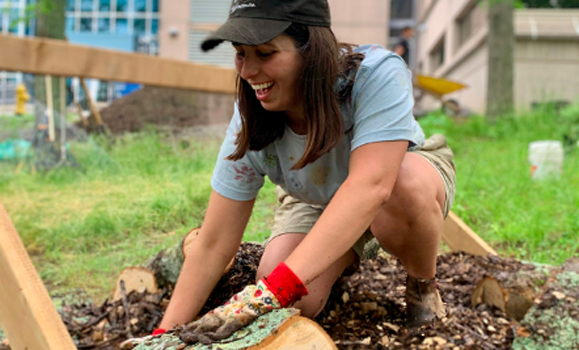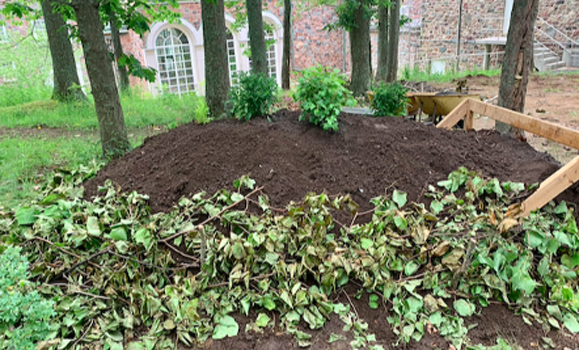A wooded area tucked behind Shirreff Hall residence on Studley Campus is the site of an exciting new project that promises to bring greater biodiversity back to this charming corner of campus.
Samantha Ceci, a Master of Resource and Environmental Management student, teamed up with DalŌĆÖs Office of Sustainability and Facilities Management to create a so-called 'hugelkultur bed.ŌĆÖ A hugelkultur bed is a mound-shaped raised garden bed created using different shapes and sizes of wood debris.
The goal of the project ŌĆö funded with assistant from a WWF Canada Go Wild Grant ŌĆö is to restore what is essentially a monoculture woodland area on campus into a mixed forest that will support a diversity of pollinator species (butterflies, bees, birds, etc.). It will also serve as an attraction for the Dalhousie community.
"I was really fascinated with idea that people were growing food in a community garden using the by-product and scraps found around the space,ŌĆØ says Samantha, pictured below. ŌĆ£I thought, ŌĆśThis a very sustainable solution.ŌĆÖŌĆØ

In a hugelkultur bed, debris underneath churns and starts to digest over time, creating more fertile soil for the plants to grow their roots in. The mound shape of the bed introduces a kind of micro-topography into the space, allowing plant species to grow. Each location on the mound has different light conditions, water availability, which will that enhance the biodiversity of the space.
ItŌĆÖs the second new biodiversity initiative introduced on Studley Campus this year. An Indigenous pollinator garden opened nearby in June on the north side of the Henry Hicks Building, a partnership between the Dalhousie Art Gallery and members of Dal's Indigenous Advisory Council.
 ╠²
╠²
Making the bed
A range of plant species were chosen, each possessing unique colours and flower shapes so as to provide pollinator species with a variety of energy sources. The plants will flower at different times of the year, staggered from June to October. The overall goal behind selecting the plant species was to address the phenological mismatch (when interacting species change the timing of regularly repeated phases in their life cycles at different rates) between plants and pollinators, which is being exacerbated by climate change.
Plants included in the garden are Common Witch Hazel, Dakota Goldrush, American High Bush Cranberry, New England Aster, Annabella Deep Pink Cut-Leaved Windflower, and Alert New York Aster.

Samantha and a group of volunteers gathered on campus recently to build the bed, which required a number of different steps. Below, youŌĆÖll find a few highlights from the event, which began with an Indigenous land acknowledgement:
┬Ę╠²╠²╠²╠²╠² The first step was placing coarse woody material like tree stumps, within the frame of the bed (4'x8') and fill the spaces between the stumps with wood chips.
┬Ę╠²╠²╠²╠²╠² Tree branches were then layered on top of the stumps. The branches decreased in thickness as the bed was built up.
┬Ę╠²╠²╠²╠²╠² Leaves were added between and over top of the branches.
┬Ę╠²╠²╠²╠²╠² Brush ŌĆśmatressingŌĆÖ was performed over the top of the leaves by weaving coniferous and deciduous branches amongst each other. Doing so helps retain and stabilize all the loose material.
┬Ę╠²╠²╠²╠²╠² Finally, the bed was covered in six inches of soil and native pollinator species were planted within this immediate soil horizon.
Samantha says students, staff and faculty members are encouraged to visit the garden, where they will be able to learn about the building process and observe plant growth through different seasons.
ŌĆ£We hope that people visiting the garden will be inspired to adopt pollinator-friendly habits in their own lives.ŌĆØ
To learn more visit on Instagram.

